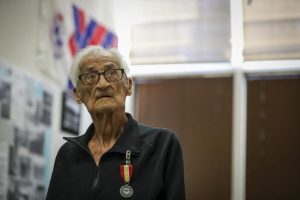It was still unclear Friday whether Army soldiers killed and injured in the drone attack by an Iran-backed militia on a logistics base in Jordan will be awarded combat accolades.
All three soldiers killed in the strike were from the same Georgia reserve unit, and at least 40 Army National Guardsmen and airmen were injured, just the latest in a growing tally of troops wounded amid increasing violence in the Middle East. But the service is still mulling whether the soldiers are eligible for combat badges and Purple Hearts.
The Army awards those badges to soldiers who are engaged by the enemy under certain circumstances, but the policy for the awards is vague. Purple Hearts and combat badges serve as key receipts for troops and veterans seeking care and compensation from the Department of Veterans Affairs, and are often the easiest way to prove a service member was in harm’s way.
Read Next: Last of 3 Soldiers Killed in Jordan Drone Strike Is Posthumously Promoted as Biden Attends Dignified Transfer
“Jordan meets [the] criteria for locations in which troops are eligible for [combat badges],” an Army spokesperson told Military.com in a statement. “Individual awards are considered on a case-by-case basis and processed commensurate with approval authorities.”
On Tuesday, Military.com asked the Pentagon’s top spokesman, Maj. Gen. Pat Ryder, whether the troops in Jordan qualified for combat awards. Ryder said he didn’t know and would look into it.
As of Friday, the Pentagon had not yet provided an answer.
Sgt. Kennedy Sanders, Sgt. Breonna Moffett and Staff Sgt. William Jerome Rivers, all Army reservists, died in Sunday’s attack in Jordan, which in the past was generally not considered a dangerous assignment for troops.
The three soldiers were posthumously promoted this week, and their remains arrived Friday at Dover Air Force Base in Delaware with President Joe Biden and Defense Secretary Lloyd Austin in attendance.
The Guardsmen injured in the attack were from the Arizona National Guard’s 1-158th Infantry Battalion; the California Guard’s 40th Infantry Division; the Kentucky Guard’s 138th Field Artillery Brigade; and New York’s 101st Expeditionary Signal Battalion.
An additional 12 airmen were also injured, from that service’s National Guard and reserve.
What qualifies for action eligible for a combat badge under Army policy is muddy, vague and somewhat contradictory.
The policy, which was updated in January, notes the engagement must be “ground combat,” but doesn’t include a clear definition of that, or whether aerial attacks count. It also notes soldiers must be executing an “offensive or defensive act,” but does not outline what that means.
Soldiers must also be receiving so-called imminent danger or hostile fire pay, a bonus of up to $225 per month for service members serving in an area where enemy contact is possible — a bonus troops in the base attacked in Jordan were receiving.
Meanwhile, more than 100 other troops have been injured in attacks by Iran proxy groups in Iraq and Syria since Israel launched a war against Hamas in the Gaza Strip in October following a surprise attack on Israeli civilians.
Two months after the attacks began, Military.com reported that just five Purple Hearts had been awarded. Since then, Military.com has repeatedly asked the Pentagon and U.S. Central Command for an updated total, but they have declined to comment.
Most of the wounds appear to be traumatic brain injuries, or TBIs. One of the earliest attacks on the al-Tanf garrison in Syria left 17 injured — of that total, 15 were diagnosed with TBI. Chief Warrant Officer 4 Garrett Illerbrunn was critically wounded during a drone attack in Iraq on Christmas when a piece of shrapnel hit his head and damaged his brain.
Defense officials haven’t offered a total figure of TBIs to reporters recently. The Pentagon has said almost all of those troops have since returned to duty.
Some officials have made remarks that seem to downplay the severity of the brain injuries, which studies and evidence show can lurk in the shadows but lead to increased risks for illnesses such as dementia and Alzheimer’s disease, and also of death by homicide, accidents and suicide.
John Kirby, the spokesman for the White House’s National Security Council, told ABC’s “Good Morning America” in late January after an attack that troops were “being seen for traumatic brain injuries, with some symptoms of concussions, but no serious physical injuries other than that.”
In years past, awards have sometimes been kept from injured troops when officials dismissed the severity of the wounds. One senior defense official said that, while most of the injuries were “from concussive events,” they were “not necessarily wounds.”
It wouldn’t be the first time the Pentagon has not taken TBIs seriously. Military.com has reported that the struggle to recognize the condition goes back to the earliest years of the Global War on Terror and that dithering cost many troops their lives.
As recently as 2020, then-President Donald Trump downplayed injuries after an Iranian missile barrage against Al Asad Air Base in Iraq that eventually led to 109 troops being diagnosed with traumatic brain injury.
“I heard they had headaches and a couple of other things,” Trump told reporters at the time. “But I would say, and I can report, it is not very serious. Not very serious.”
The dismissal led to a two-year delay in National Guardsmen receiving their Purple Hearts. Military.com interviewed some of them, who said the injuries have been debilitating.
Related: 5 Purple Hearts Awarded to Injured Troops After Spike in Attacks on Bases in Iraq, Syria
Story Continues
Please rate this CIBA article
Vote






